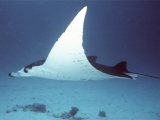11 September 2006
Preserve the Manta Ray in Indonesia
 A Flying Manta Project has been initiated by Ivan Choong who is "proud to be using my skills with underwater photography to contribute back to conservation".
A Flying Manta Project has been initiated by Ivan Choong who is "proud to be using my skills with underwater photography to contribute back to conservation".The Manta ray has been listed on the 2005 IUCN Red List, along with four species of Mobula rays.
Thousands of Manta rays are slaughtered annually by fishermen in Indonesia, Mexico and although now illegal, the Philippines, for food and to supply powdered brachial elements for Asian traditional medicine. This demand has changed the Indonesian fishery from a subsistence fishery catching 200-300 Mantas/year to a commercial fishery catching between 1,000-2,400 Mantas/year.
Ivan hopes to increase governments' and NGOs' awareness of Manta rays' vulnerability to fishing pressure. The long lifespan, late maturity and low reproductive rate of Manta rays make them a poor target fishery because they cannot quickly replace adults that are removed from a population. Mantas live 50--100 years, reach maturity at 8--10 years, and have only one pup every 1--3 years.
Ivan's objective is to conduct research on the Manta rays in Bali with the aim of promoting Manta ray conservation in the SE Asia region. All data gathered will be analysed in collaboration with local researchers in Singapore, Indonesia and the Manta Pacific Research Foundation based in Hawaii.
There is a 95% success rate of spotting Mantas when diving at Manta Point (southwest Nusa Penida, Bali's largest offshore island) so for Phase I of the project, for almost three weeks in Aug 06, Ivan looked into the migratory patterns of Mantas at Manta Point by cataloguing those sighted daily.
This was done by photographing the specific markings on their undersides, assigning a project number to each, and keeping records of the frequency of their visits to Manta Point; as well as keeping records of daily weather and tidal conditions, the time of day, and the number of Mantas at the start of each dive.
For Phase II, in August 2007: the project will expand to include more participants and guest researchers.
For Phase III, in August 2008: an increased number of participants and continuation of data collection.
Anyone wishing further information can contact Ivan on: flyingMantaproject@i-nsc.net
Source: Aquamarine Diving Bali
--
Subscribe to SCUBA News (ISSN 1476-8011) for more free news, articles, diving reports and marine life descriptions - http://www.scubatravel.co.uk/news.html

 Subscribe to SCUBA News (ISSN 1476-8011) for more news, articles, diving reports, reviews and marine creature of the month.
(SCUBA News is published by SCUBA Travel once a month. Will will keep your e-mail address confidential and only use it to send you the monthly newsletter.)
Subscribe to SCUBA News (ISSN 1476-8011) for more news, articles, diving reports, reviews and marine creature of the month.
(SCUBA News is published by SCUBA Travel once a month. Will will keep your e-mail address confidential and only use it to send you the monthly newsletter.)

